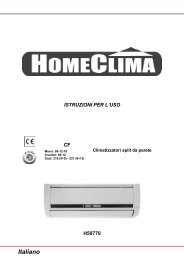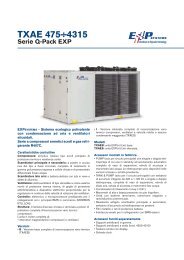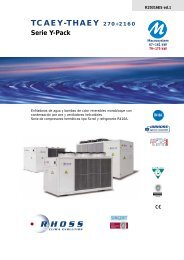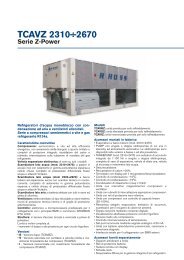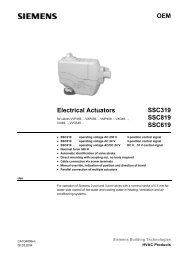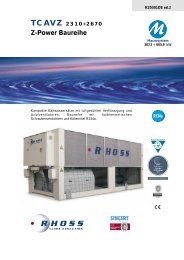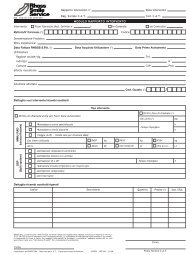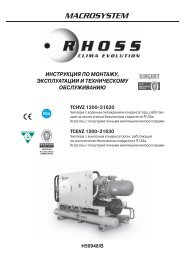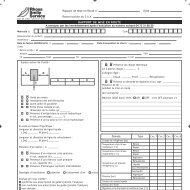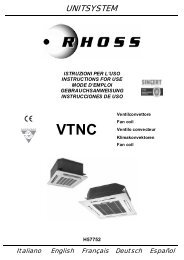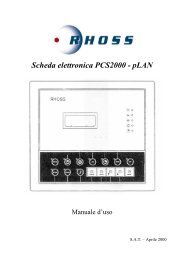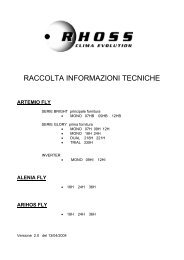SPLIT-SYSTEM - Rhoss
SPLIT-SYSTEM - Rhoss
SPLIT-SYSTEM - Rhoss
You also want an ePaper? Increase the reach of your titles
YUMPU automatically turns print PDFs into web optimized ePapers that Google loves.
SECTION II: INSTALLATION AND MAINTENANCE<br />
Left<br />
Back<br />
centre<br />
Back<br />
left<br />
Towards the<br />
bottom left<br />
Use the support<br />
brackets.<br />
Fig. 7<br />
Right<br />
Back<br />
right<br />
• make the refrigerant, electric and condensation drain connections as<br />
specified in the “Refrigerant connections” and “Electric connections”<br />
paragraphs;<br />
• before removing the casing, check that the condensation drain is<br />
working properly.<br />
II.2.4<br />
Towards the<br />
bottom right<br />
EXTERNAL UNIT INSTALLATION<br />
Fig. 4<br />
Secure the unit to the support plate,<br />
making sure that the refrigerant lines, the<br />
electric cables and the condensation drain<br />
pipe run through the hole in the wall.<br />
Fig. 5<br />
The external unit must be installed outdoors, respecting the minimum<br />
technical clearance distances in order to allow the passage of air and<br />
the execution of any necessary maintenance operations.<br />
Water is produced in heat pump models, during the heating mode<br />
defrosting phase. This water needs to be collected and channelled to<br />
the drain.<br />
II.2.5<br />
REFRIGERANT CONNECTIONS<br />
IMPORTANT!<br />
The refrigerant connections must be made by<br />
specialist personnel in compliance with laws and<br />
regulations in force in the country of installation.<br />
RHOSS S.p.A. shall not be held liable for damage<br />
to persons or property caused by incorrect<br />
connections.<br />
Copper pipes for cooling systems must be used for refrigerant lines,<br />
respecting the lengths and diameters recommended in the enclosed<br />
documents. Make sure there are no impurities or moisture inside the<br />
pipes as this is extremely harmful for the refrigerant circuit. The<br />
refrigerant lines must each be insulated individually with lagging of<br />
closed-cell expanded material.<br />
A 65 mm hole is sufficient for the passage of the pipes through the<br />
walls.<br />
Proceed as follows to prepare the pipes.<br />
Cut the connection pipes at the set distance, leaving a certain safety<br />
margin and bearing in mind the tips indicated in Fig. 8.<br />
Right<br />
Wrong<br />
Make sure that the unit is<br />
level.<br />
Fig. 6<br />
Eliminate any cutting burr while keeping the pipe opening facing<br />
downwards to prevent the ingress of debris.<br />
Fig. 8<br />
The consistency of the wall must be sufficient for the weight of the unit<br />
and must not permit the transmission of noise or vibrations.<br />
Particular care must be taken when selecting the area, so that the air<br />
flow does not disturb the neighbours.<br />
Cover the refrigerant lines with suitable<br />
insulation and then insert the nozzles which<br />
had previously been removed from the unit<br />
connections.<br />
Fig. 9<br />
32



